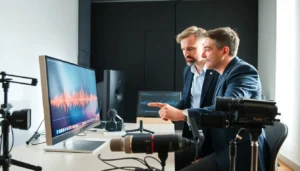Picture this: a satellite in distress, spinning aimlessly like a lost sock in the dryer. Enter on-orbit servicing, the superhero of space tech, swooping in to save the day. This innovative approach isn’t just about fixing broken satellites; it’s about giving them a second chance at life, and maybe even a mid-life crisis makeover.
Table of Contents
ToggleOverview of On-Orbit Servicing
On-orbit servicing represents a transformative advancement in space technology. This process extends the functionality of satellites, ensuring they continue to meet operational needs.
Definition and Importance
On-orbit servicing refers to the ability to perform maintenance, repairs, and upgrades on satellites while they remain in orbit. This capability plays a crucial role in extending the operational life of satellites, minimizing waste, and maximizing investment. Servicing can involve refueling, replacing components, or even upgrading systems to incorporate new technologies. By addressing issues that otherwise lead to decommissioning, on-orbit servicing enhances mission reliability and reduces costs associated with satellite replacements. This technology not only supports aging satellites but also paves the way for more sustainable practices in space operations.
Historical Context
Development of on-orbit servicing technology traces back to the early 1990s when NASA’s Space Shuttle program demonstrated potential for satellite repairs. Noteworthy missions, like the servicing of the Hubble Space Telescope, showcased successful repairs and upgrades, highlighting the technology’s value. In 2002, the first private company, Orbital Sciences Corporation, conducted a demonstration mission for on-orbit servicing. Recent advancements, such as the work by companies like Northrop Grumman and the European Space Agency, further illustrate growing interest and investment in this area. With increased satellite launches, the demand for servicing capabilities has become more pressing and significant in today’s space economy.
Technologies Enabling On-Orbit Servicing

On-orbit servicing relies on advanced technologies that enhance satellite lifespan and capabilities. Two key areas significantly contribute to this innovative field.
Robotic Systems
Robotic systems play a crucial role in executing complex tasks during servicing missions. These systems can maneuver precisely to perform repairs or upgrades on satellites in orbit. Remote-controlled manipulators facilitate delicate operations, such as replacing components or conducting inspections. Autonomous robots also support the servicing process by performing routine tasks without human intervention. For example, some robotic systems from Northrop Grumman are designed to capture and stabilize satellites, ensuring safe handling. The integration of advanced robotics enables safer and more efficient servicing missions, fostering growth in the space sector.
Refueling Techniques
Refueling techniques represent another vital aspect of on-orbit servicing. Innovative methods allow satellites to replenish their fuel supplies, thus extending their operational life. Specialized docking systems, developed by companies like the European Space Agency, enable seamless refueling operations. These systems connect to satellites while in orbit, delivering propellant without the need for complete satellite retrieval. Utilizing cryogenic fuels and pressurized gases, refueling can enhance maneuverability and functionality. Effective refueling techniques not only optimize satellite performance but also minimize the need for constructing new satellites, promoting sustainability in space operations.
Current Applications of On-Orbit Servicing
On-orbit servicing encompasses various applications that enhance satellite functionality and sustainability. These services include maintenance and upgrades, benefiting both existing missions and future space endeavors.
Satellite Maintenance
Satellite maintenance involves routine tasks that extend operational life. Technicians perform repairs and upgrades without returning the satellite to Earth. Systems equipped with robotic manipulators conduct inspections and address issues swiftly. Companies like Northrop Grumman have demonstrated successful maintenance missions, showing the potential for efficient repair in space. This approach minimizes waste and reduces the economic impact of satellite failures. Ongoing missions illustrate that regular maintenance keeps satellites performing optimally, ensuring continued service and reliability.
Spacecraft Upgrades
Upgrading spacecraft paves the way for enhanced capabilities and new technologies. Satellites can receive advanced instruments and improved communication systems while remaining in orbit. This capability allows for adjustments based on technological advancements or mission changes. Innovative designs like modular systems facilitate the easy integration of upgrades. The European Space Agency has explored these modifications, demonstrating significant advantages in mission longevity and effectiveness. Consequently, performing upgrades in orbit optimizes investments and prepares satellites for evolving mission requirements.
Future Prospects for On-Orbit Servicing
On-orbit servicing is poised for significant advancements that could reshape the aerospace industry and extend satellite capabilities.
Emerging Innovations
Innovative electronics will improve robotic systems used in servicing. Advanced AI technologies will enhance autonomous navigation and performance of repair tasks. Data analytics tools will enable real-time assessments for satellite conditions. New docking mechanisms are under development, aimed at streamlining refueling efforts while satellites remain operational. Some companies are exploring the use of advanced materials for replacement components, which will improve durability and efficiency. Continued research into in-space manufacturing may lead to on-demand part production, further increasing mission sustainability. All these innovations support the goal of extending satellite life and enhancing mission effectiveness in orbit.
Potential Market Growth
The on-orbit servicing market is expected to grow significantly in the coming years. Recent estimates predict a compound annual growth rate exceeding 15%, driven by rising satellite launches and market demands. Increasing competition among private companies is fostering innovation and providing various servicing options. Governments and private entities are investing heavily, signaling strong interest in this technology. This sector’s projected worth could reach billions by the end of this decade, indicating a robust appetite for long-term satellite support. Expanding applications, from maintenance to upgrades, further underline this growth potential and suggest a dynamic shift in how space assets are managed.
On-orbit servicing is poised to revolutionize the aerospace industry by enhancing satellite longevity and performance. As technology advances and investment in this sector grows, the potential for improved satellite management becomes increasingly apparent. With innovative solutions like robotic systems and refueling techniques, the future of space operations looks promising.
The shift towards on-orbit servicing not only minimizes waste but also optimizes the economic viability of satellite missions. As the market expands, the implications for sustainability and efficiency in space will be profound. This transformative approach is set to redefine how satellites are maintained and upgraded, ensuring they remain valuable assets in an ever-evolving space landscape.







